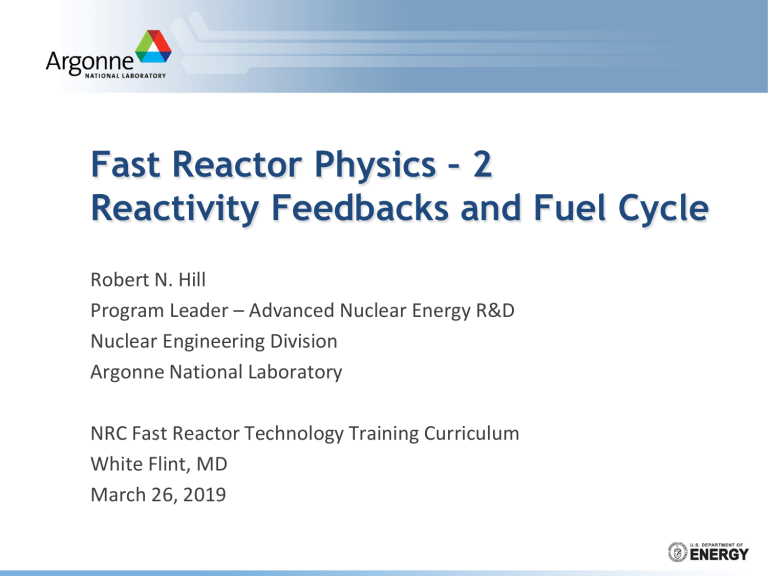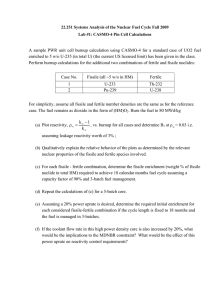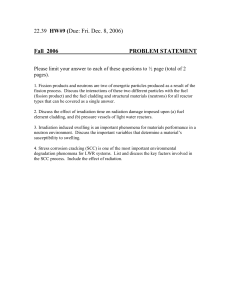
Fast Reactor Physics – 2 Reactivity Feedbacks and Fuel Cycle Robert N. Hill Program Leader – Advanced Nuclear Energy R&D Nuclear Engineering Division Argonne National Laboratory NRC Fast Reactor Technology Training Curriculum White Flint, MD March 26, 2019 Work sponsored by U.S. Department of Energy Office of Nuclear Energy, Science & Technology Outline Fast Reactor Reactivity Feedbacks – Delayed Neutron Fraction – Geometric Expansion Coefficients – Doppler Coefficient – Coolant Density/Void Coefficient Fuel Cycle Implications – Breeder vs. Burner Configurations – Conventional Advanced Fuel Recycle Options – “Traveling Wave” Concepts 2 Fast Spectrum Physics Distinctions Combination of increased fission/absorption and increased number of neutrons/fission yields more excess neutrons from Pu-239 – Enables “breeding” of fissile material In a fast spectrum, U-238 capture is more prominent – Higher enrichment (TRU/HM) is required (neutron balance) – Enhances internal conversion Reduced parasitic capture and improved neutron balance – Allows the use of conventional stainless steel structures – Slow loss of reactivity with burnup • Less fission product capture and more internal conversion The lower absorption cross section of all materials leads to a much longer neutron diffusion length (10-20 cm, as compared to 2 cm in LWR) – Neutron leakage is increased (>20% in typical designs, reactivity coefficient) – Reflector effects are more important – Heterogeneity effects are relatively unimportant 3 Whole-Core Reactivity Coefficients for Different Size Fast Reactors 250 MWt ABTR 1000 MWt ABR 3500 MWt US-Europe 0.0033 0.00334 0.0035 Μs 0.33 0.38 0.32 Radial expansion coefficient ¢/◦ C -0.43 -0.38 -0.21 Axial expansion coefficient ¢/◦ C -0.05 -0.05 -0.07 Sodium density coefficient ¢/◦ C 0.03 0.13 0.18 Doppler coefficient ¢/◦ C -0.10 -0.13 -0.13 Sodium void worth $ 1.10 4.93 7.29* (4.98) ¢/◦ C -0.07 -0.09 -0.09 unit Effective delayed neutron fraction Prompt neutron lifetime Sodium voided Doppler coefficient Power coefficient is quite negative – More negative at smaller size because of radial expansion coefficient – Sodium density coefficient also more positive at larger size Physics underlying each coefficient will be explained 4 Delayed Neutron Fraction Hummel and Okrent – Reactivity Coefficients in Large Fast Power Reactors, ANS, 1970 is a good reference for underlying physics Delayed neutron fraction dominated by key fission isotopes – Low (0.2%) for Pu-239 – High (1.5%) for U-238 – Between 0.3-0.5% for higher plutonium isotopes – Particularly low (<0.2%) for minor actinides Net result is 0.3-0.4% for conventional compositions – Slightly lower burner designs (~0.2% for pure burner) Higher for U-235 enriched systems (LWRs) – Delayed neutron fraction for U-235 is ~0.67% Delayed neutron fraction is an indicator of sensitivity – At low values, response to small changes in the reactivity is magnified and power can change more quickly – Feedback effects can be favorable or not depending on the transient 5 Geometric Expansion Coefficients Whole-core coefficients are computed by eigenvalue difference for a small change in each dimension Radial expansion – uniform expansion of grid plate by 1% – Reduction of fuel/structure densities by 1% – This allows more axial leakage in particular Axial expansion – uniform expansion of fuel by 1% – Reduction of fuel density by 1% – Allows more radial leakage – Also, effectively inserts the control rods which remain stationary – In some cases, fuel assumed bound to clad for axial expansion These feedbacks are very important for fast reactor transient behavior – Tied to different material temperatures (load pads, grid plate, fuel) – Thus, timing will be different 6 Neutron Balances of Radial and Axial Expansions Base Case Radial Expansion Axial Expansion balance balance 100.00 100.00 100.00 0.18 0.18 0.18 Absorption 68.89 68.93 -0.04 68.93 -0.05 Leakage 31.54 32.16 -0.63 31.61 -0.07 Fission source (n,2n) source ∆ρ (%) balance ∆ρ (%) Radial 17.49 17.72 -0.23 17.59 -0.10 Axial 14.05 14.45 -0.40 14.02 0.03 Sum -0.67 -0.12 To first order, radial expansion is an axial leakage effect, and Axial expansion is a radial leakage effect! Because the height is the short dimension (more axial than radial leakage), the radial expansion coefficient is more negative Axial absorption effect can be magnified by effective control rod insertion 7 Doppler Coefficient Doppler coefficient arises primarily from U-238 resonance broadening – Enhanced by high U-238 content • Reduced Doppler for high enrichment burner concepts – Self-shielding effect more pronounced at low energies (keV range) • Doppler enhanced by spectral softening • Voided Doppler is smaller from spectral shift Temperature dependence in fast spectrum is different than LWR – Doppler range from 1/T1/2 for large to 1/T3/2 for small resonances – For typical FR, an approximate 1/T dependence observed There is also a structural Doppler reactivity effect (~1/3 fuel Doppler) – However, tied to temperature of steel, not fuel (different timing) Doppler feedback is not helpful in all transients – For example, when trying to cool the fuel to shutdown condition (e.g., ULOF), it is a positive feedback – Conversely prompt negative feedback in UTOP transient 8 Reactivity Swing for Power Reduction Oxide Fuel (Doppler Coeff. = - 0.005) 892oC BP ~1.5 $ Metallic Fuel (Doppler Coeff. = - 0.003) ~0.3 $ 360oC Inlet 9 Coolant Density Coefficient Coolant density coefficient computed by first-order perturbation theory to evaluate small density (temperature variation) impacts Spectral effect – Reduced moderation as sodium density decreases – In fast regime, this is a positive reactivity effect • From Pu-239 excess neutrons and threshold fission effects Leakage effect – Sodium density decrease allows more neutron leakage – This is a negative reactivity effect in the peripheral regions Capture effect – Sodium density decrease results in less sodium capture – This is a relatively minor effect Void worth is evaluated using exact perturbation theory to account for shift in flux distribution and change in cross sections for voided condition In general, 10% more positive than the first-order density worth 10 Spectral Variation of Neutron Cross Sections: Pu-239 Fission and capture cross section >100X higher in thermal range Sharp decrease in capture cross section at high energy 11 Sodium Void Worth by Components ($) 1000 MWt ABR (startup metal core) 250 MWt ABTR (startup metal core) Capture Spectral Leakage Total BOC 0.5 9.1 -5.2 4.4 EOC 0.5 9.9 -5.5 4.9 BOC 0.4 6.4 -5.8 1.0 EOC 0.4 6.6 -5.8 1.1 Flowing sodium completely voided in ALL active and above-core regions Void worth tends to increase with core size However, difficult to conceive transient situations that reach boiling – Low pressure system – >300oC margin to boiling – Other feedbacks are negative to get to voiding! Extensive report on void worth reduction – Khalil and Hill, NSE, 109 (1995) 12 Outline Fast Reactor Reactivity Feedbacks – Delayed Neutron Fraction – Geometric Expansion Coefficients – Doppler Coefficient – Coolant Density/Void Coefficient Fuel Cycle Implications – Breeder vs. Burner Configurations – Conventional Advanced Fuel Recycle Options – “Traveling Wave” Concepts 13 Conventional 1000 MWt SuperPRISM (Metal Core) P Driver (138) P S P Internal blanket (49) P Radial blanket (48) S P P P S P P Primary control (9) S Secondary Control (3) Reflector (126) P Shield (72) GEM(6) Total (451) Internal and external blankets allocated – Result in conversion ratio of ~1 Only 12 control rod locations with very low burnup reactivity losses Blanket, two row reflector, and boron carbide for radial shielding 14 Burner 1000 MWt Preliminary ABR Burner Design P P P S P P Inner core (78) Outer core (102) P Reflector (114) P P P S S P S P P P P P P Primary control (15) S Secondary control (4) Shield (66) Total (379) Two enrichment zones to reduce radial power peaking No blankets allocated for conversion ratio < 1 Additional (20) control rod locations for burnup reactivity losses Similar radial shield configuration 15 Neutron Balance PWR U-235 or TRU enrichment, % Source fission CR=0.5 4.2 13.9 33.3 100.0% 99.8% 99.9% 0.2% 0.1% 22.9% 28.7% 3.5% radial 3.0% 12.3% 16.6% axial 0.4% 10.6% 12.1% absorption Loss CR=1.0 (n,2n) leakage SFR fuel 96.5% 77.1% 71.3% 76.7% 71.8% 62.2% (27.2%) (31.6%) (17.1%) coolant 3.4% 0.1% 0.1% structure 0.6% 3.7% 3.7% fission product 6.8% 1.5% 2.4% control 9.0% 0.0% 2.9% (U-238 capture) Conversion ratio defined as ratio of TRU production/TRU destruction – Slightly different than traditional breeding ratio with fissile focus 16 Actinide Management in Fast Reactors Energy Production Reactor A wide variety of actinide management Recycle Used strategies possible – Waste management – Resource extension Extend Uranium Resources Uranium Favorable features for small reactor applications – Compact (high power density) – Extended burnup and cycle length – Inherent safety Favorable features for plutonium management – High loading and throughput possible Recycle Reactor With key technology development, also intended for electricity, heat production, or other energy product missions Recycle Fuel Fabrication 17 Fast Reactors are Flexible for Actinide Management Can be configured as modest breeders (CR≥1) to moderate burners (CR≥0.5) with conventional technology Low conversion ratio designs (CR<0.5) have been investigated for transmutation applications Low Enrichment Fuel – High enrichment fuels are required (~50% TRU/HM for CR=0.25) – Non-uranium fuel would be needed to achieve CR=0 High Enrichment Fuel Reflector Shield Control Ultimate Shutdown Gas Expansion Module Safety performance will change at low uranium content (e.g., reactivity losses, reduced Doppler coefficient) – Detailed safety analysis conducted for CR=0.25 SFR system – Inherent safety behavior is not compromised Compact low conversion ratio design COE is similar to reference system – High leakage configuration increases cost by 20% – Fuel cost and capacity factor differences are important 18 Transmutation Approach for Improved Waste Management Long-term heat, radiotoxicity, and dose are all dominated by the Pu-241 to Am-241 to Np-237 decay chain Destruction of the transuranics (TRU) is targeted to eliminate the problematic isotopes Some form of separations is necessary to extract transuranic elements for consumption elsewhere The transuranic (TRU) inventory is reduced by fission – Commonly referred to as ‘actinide burning’ – Transmutation by neutron irradiation – Additional fission products are produced In the interim, the TRU inventory is contained in the fuel cycle 19 1.00 0.90 0.80 0.70 0.60 0.50 0.40 0.30 0.20 0.10 0.00 PWR 24 4 Cm 24 3 Am 24 1 Am Pu 24 2 Pu 24 1 Pu 24 0 Pu 23 9 Pu 23 8 Np 23 7 SFR U2 38 U2 35 Fission/Absorpt Impact of Energy Spectrum on Fuel Cycle (Transmutation) Performance Fissile isotopes are likely to fission in both thermal/fast spectrum – Fission fraction is higher in fast spectrum Significant (up to 50%) fission of fertile isotopes in fast spectrum Net result is more excess neutrons and less higher actinide generation in FR 20 Fuel Cycle Implications of Reactor Physics The reactor spectral differences lead to fuel cycle strategies: Thermal reactors typically configured for once-through (open) fuel cycle – They can operate on low enriched uranium (LEU) – They require an external fissile feed (neutron balance) – Higher actinides must be managed to allow recycle • Separation of higher elements – still a disposal issue • Extended cooling time for curium decay Fast reactors are typically intended for modified open or full recycle with uranium conversion and resource extension – Higher actinide generation is suppressed – Neutron balance is favorable for recycled TRU • No external fissile material is required • Can enhance U-238 conversion for traditional breeding • Can limit U-238 conversion for burning 21 Fast Spectrum Breed and Burn Principles Enriched U-235 (or Pu-239) starter core would be surrounded by a blanket of fertile fuel Enriched fuel would produce neutrons that generate power and convert fertile fuel to fissionable fuel Irradiated fertile fuel would replace enriched fuel after original U-235 (or Pu-239) is burned and new Pu239 is formed Use of “Standard Breeders” exploit this physics in conjunction with reprocessing Complete U-238 conversion and fission, with the uranium utilization limited only by losses Breed and Burn concepts promote conversion, but minimize reprocessing (modified open) Travelling Wave Concept Once fertile zone dominates, once-through uranium utilization at the fuel burnup limit 22 “Traveling Wave” Concept Concepts employ a fast neutron spectrum and run on depleted uranium – DU is converted to Pu during reactor operation – Fissile material (enriched-U or Pu) is required only in the first core, to initiate the conversion Traveling wave reactor a particular variant – Fission wave propagates from fissile “starter” through the adjacent DU zone Kinf vs. burnup in a fast spectrum History of Concept 23 CANDLE Power Density Fissile Mass Fissioning zone propagates from starter thru DU region In principle, reactor operation can be extended in proportion to height of the DU region 24 Uranium Utilization Once-through systems Burnup, % Enrichment, % Utilization, % PWR-50GWd/t 5 4.2 0.6 PWR-100GWd/t 10 8.5 0.6 VHTR 10.5 14.0 0.4 Fast Burner 22.3 12.5 0.8 Recycling Systems LWR Power sharing, % Burnup, % Enrichment, % Utilization, % UOX 90 5 4.2 MOX 10 10 0.7 LWR-Fast Burner LWR-UOX Fast Burner 57 43 5 9 4.2 12.5 1.4 Fast Converter 100 ~99 Is it possible to improve U utilization significantly … • without recycle? • with limited recycle? 25 Physics Performance of Breed & Burn Concepts Conventional SFR CANDLE CBZ MB3 15 10.3 12.2 6.2 2/0.5 3.2 / 0.8 3.9 / 0.5 3.1 / 0.6 350 50 - 100 197 / 0.6 0.2 / 27.2 171 / 48 2.8/ 63.3 177 / -----5.5 / 96.1 Power peaking factor ‒ Fissile region ‒ Fertile region 1.5 4 2.45 30.1 1.49 6.84 1.84 4.61 Avg. discharge burnup (GWd/t) ‒ Fissile fuel ‒ Fertile fuel 100 30 362 248 316 198 ---277 Peak fast fluence, x1023 neutrons/cm2 ‒ Fissile fuel ‒ Fertile fuel 3.5 2.0 40.3 41.9 22.1 21.6 23.4 21.7 Fissile enrichment of starter, % Excess reactivity (max / min), %Δk Ave. power density (BOC/EOC), W/cc ‒ Fissile (starter) region ‒ Fertile (DU) region For postulated B&B concepts, fuel burnup to 20-30% However, much higher neutron damage must be tolerated 26 Summary and Conclusions Fast reactor physics are quite different from thermal reactor behavior – Better neutron balance (flexible actinide management) – Higher enrichment required to compensate U-238 capture – Neutron leakage is increased Reactivity coefficients were discussed – Expansion coefficients prominent because of high leakage – Negative power coefficient – Positive sodium density (and void coefficient) – Overall favorable inherent performance (for complete set of feedbacks) has been demonstrated Typical fast reactor configurations and fuel cycles were identified – Range from conventional blanketed breeder, to moderate burner with no blankets, to low conversion ratio (high enrichment) options – Fuel recycle strategies for waste management and resource extension – Innovative “breed and burn” once-through concepts 27 Questions? 28



